start stop button DODGE GRAND CARAVAN 2009 5.G Owners Manual
[x] Cancel search | Manufacturer: DODGE, Model Year: 2009, Model line: GRAND CARAVAN, Model: DODGE GRAND CARAVAN 2009 5.GPages: 535, PDF Size: 18.61 MB
Page 31 of 535
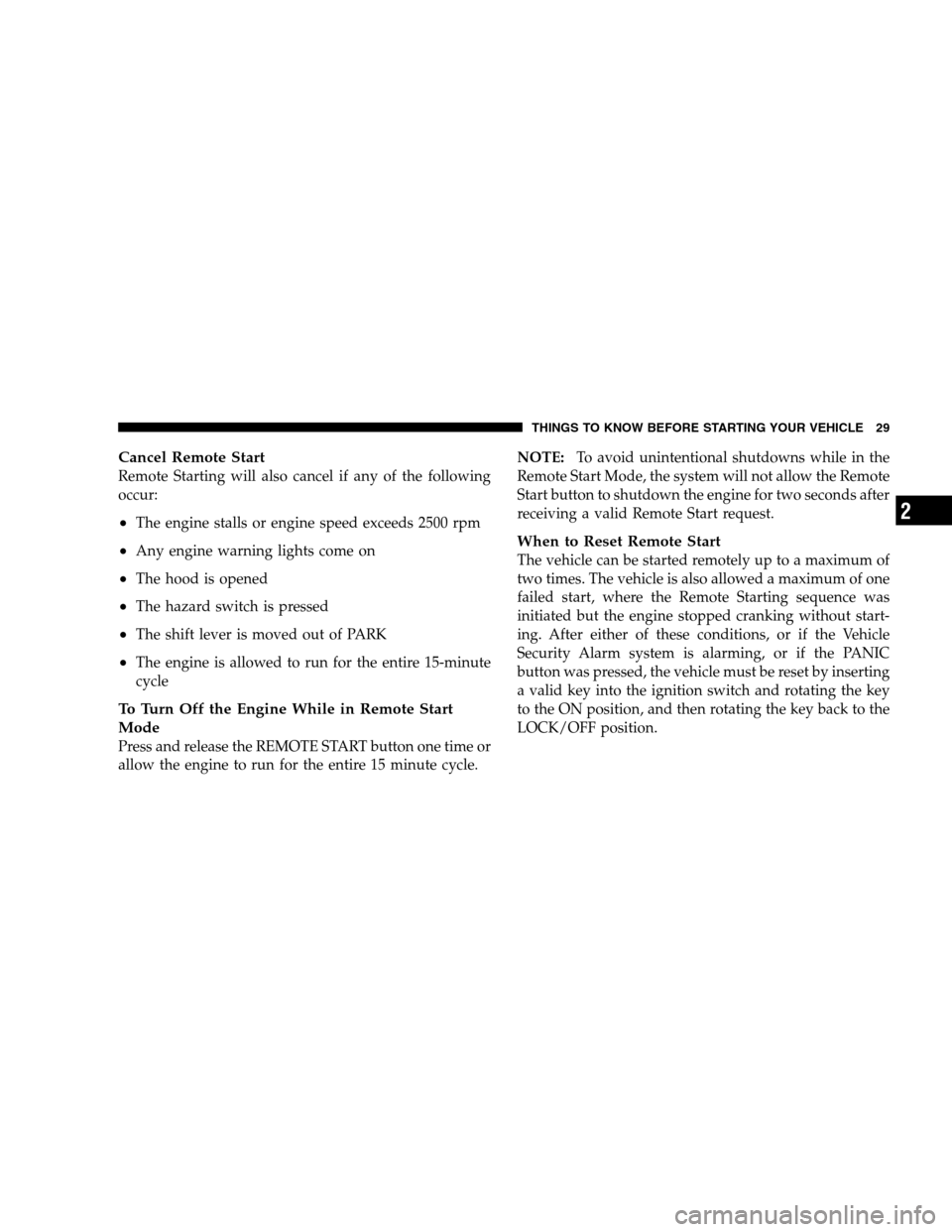
Cancel Remote StartRemote Starting will also cancel if any of the following
occur:
The engine stalls or engine speed exceeds 2500 rpm
Any engine warning lights come on
The hood is opened
The hazard switch is pressed
The shift lever is moved out of PARK
The engine is allowed to run for the entire 15-minute
cycle
To Turn Off the Engine While in Remote Start
Mode
Press and release the REMOTE START button one time or
allow the engine to run for the entire 15 minute cycle.
NOTE:
To avoid unintentional shutdowns while in the
Remote Start Mode, the system will not allow the Remote
Start button to shutdown the engine for two seconds after
receiving a valid Remote Start request.
When to Reset Remote Start
The vehicle can be started remotely up to a maximum of
two times. The vehicle is also allowed a maximum of one
failed start, where the Remote Starting sequence was
initiated but the engine stopped cranking without start-
ing. After either of these conditions, or if the Vehicle
Security Alarm system is alarming, or if the PANIC
button was pressed, the vehicle must be reset by inserting
a valid key into the ignition switch and rotating the key
to the ON position, and then rotating the key back to the
LOCK/OFF position.
THINGS TO KNOW BEFORE STARTING YOUR VEHICLE 29 2
Page 52 of 535
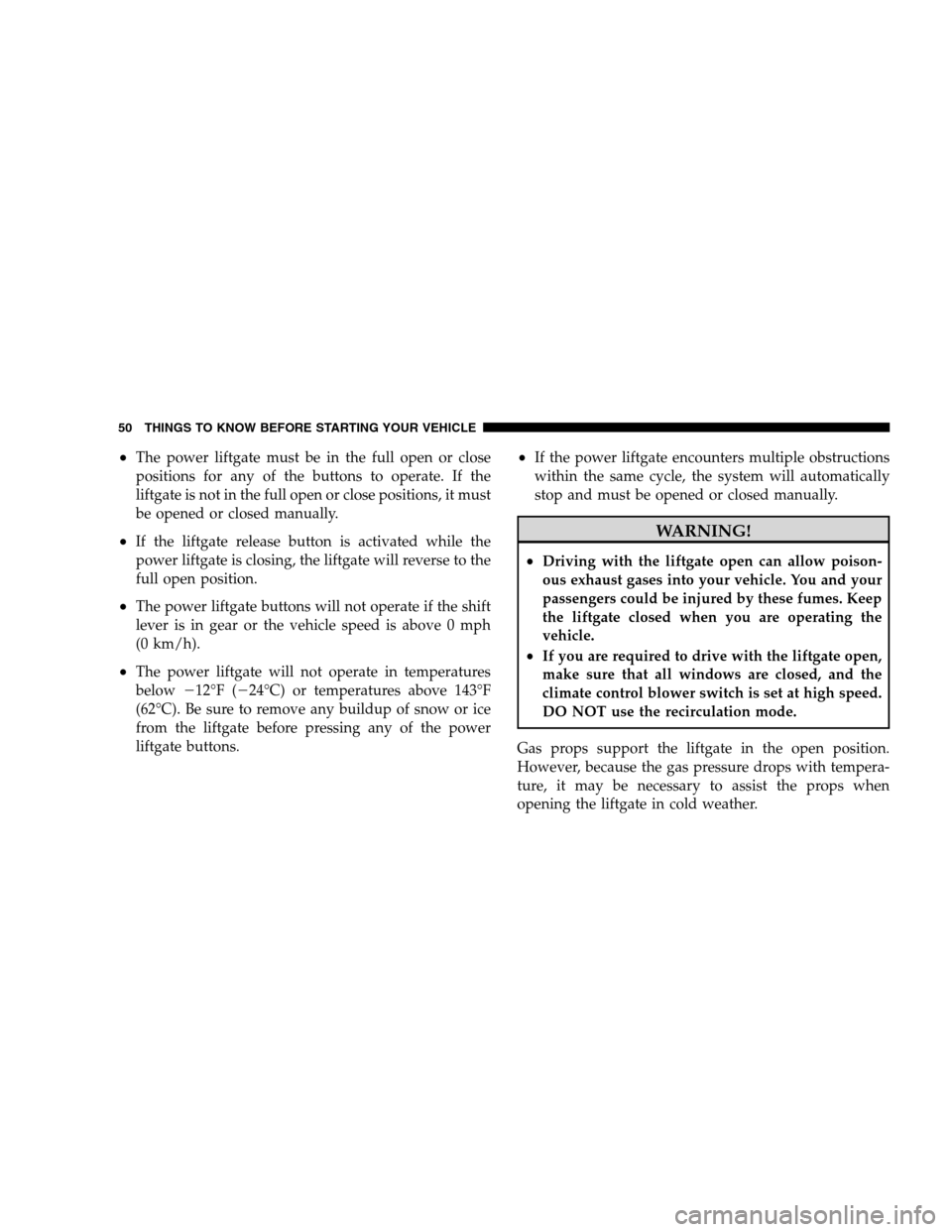
The power liftgate must be in the full open or close
positions for any of the buttons to operate. If the
liftgate is not in the full open or close positions, it must
be opened or closed manually.
If the liftgate release button is activated while the
power liftgate is closing, the liftgate will reverse to the
full open position.
The power liftgate buttons will not operate if the shift
lever is in gear or the vehicle speed is above 0 mph
(0 km/h).
The power liftgate will not operate in temperatures
below
�12°F (�24°C) or temperatures above 143°F
(62°C). Be sure to remove any buildup of snow or ice
from the liftgate before pressing any of the power
liftgate buttons.
If the power liftgate encounters multiple obstructions
within the same cycle, the system will automatically
stop and must be opened or closed manually. WARNING!
Driving with the liftgate open can allow poison-
ous exhaust gases into your vehicle. You and your
passengers could be injured by these fumes. Keep
the liftgate closed when you are operating the
vehicle.
If you are required to drive with the liftgate open,
make sure that all windows are closed, and the
climate control blower switch is set at high speed.
DO NOT use the recirculation mode.
Gas props support the liftgate in the open position.
However, because the gas pressure drops with tempera-
ture, it may be necessary to assist the props when
opening the liftgate in cold weather.
50 THINGS TO KNOW BEFORE STARTING YOUR VEHICLE
Page 85 of 535
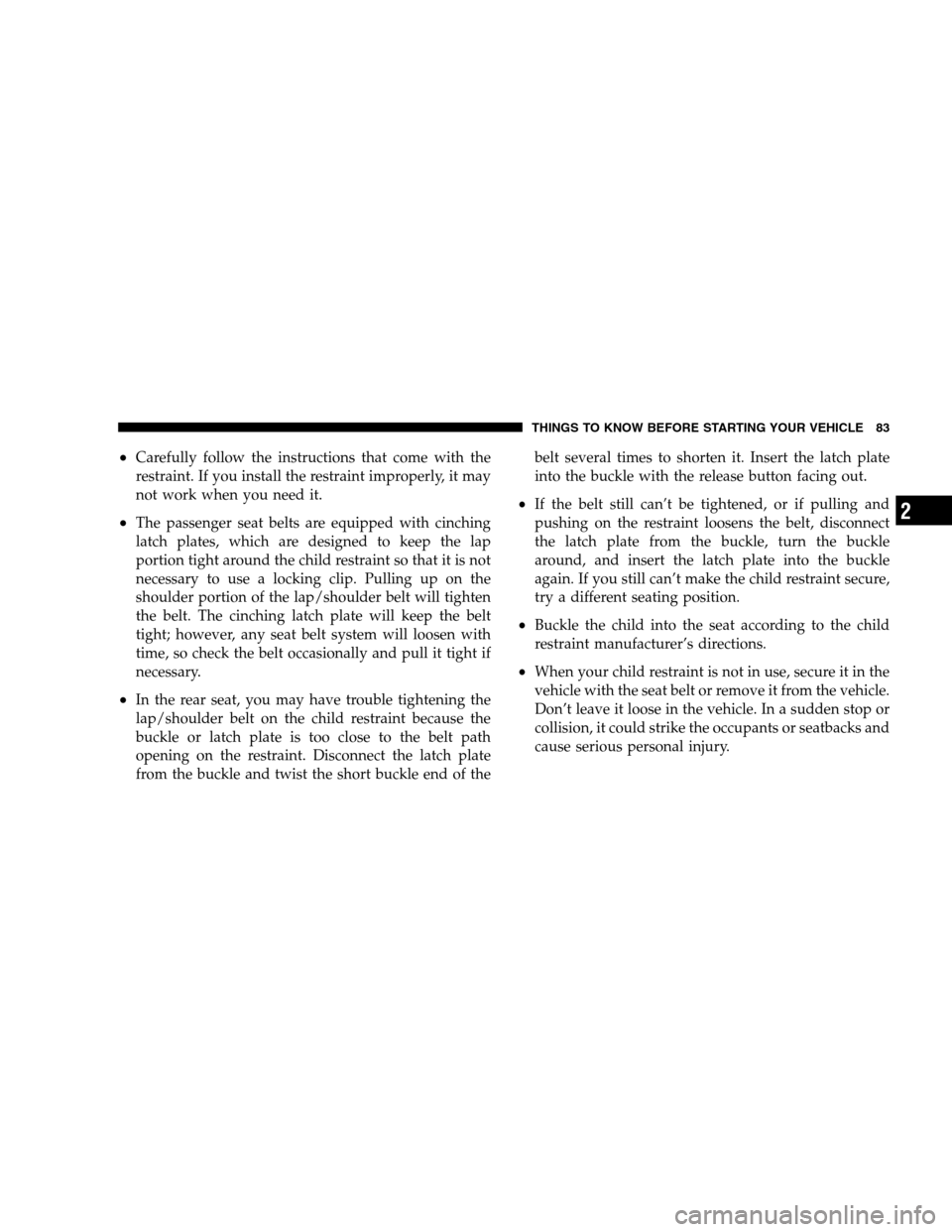
Carefully follow the instructions that come with the
restraint. If you install the restraint improperly, it may
not work when you need it.
The passenger seat belts are equipped with cinching
latch plates, which are designed to keep the lap
portion tight around the child restraint so that it is not
necessary to use a locking clip. Pulling up on the
shoulder portion of the lap/shoulder belt will tighten
the belt. The cinching latch plate will keep the belt
tight; however, any seat belt system will loosen with
time, so check the belt occasionally and pull it tight if
necessary.
In the rear seat, you may have trouble tightening the
lap/shoulder belt on the child restraint because the
buckle or latch plate is too close to the belt path
opening on the restraint. Disconnect the latch plate
from the buckle and twist the short buckle end of the
belt several times to shorten it. Insert the latch plate
into the buckle with the release button facing out.
If the belt still can’t be tightened, or if pulling and
pushing on the restraint loosens the belt, disconnect
the latch plate from the buckle, turn the buckle
around, and insert the latch plate into the buckle
again. If you still can’t make the child restraint secure,
try a different seating position.
Buckle the child into the seat according to the child
restraint manufacturer’s directions.
When your child restraint is not in use, secure it in the
vehicle with the seat belt or remove it from the vehicle.
Don’t leave it loose in the vehicle. In a sudden stop or
collision, it could strike the occupants or seatbacks and
cause serious personal injury.
THINGS TO KNOW BEFORE STARTING YOUR VEHICLE 83 2
Page 295 of 535
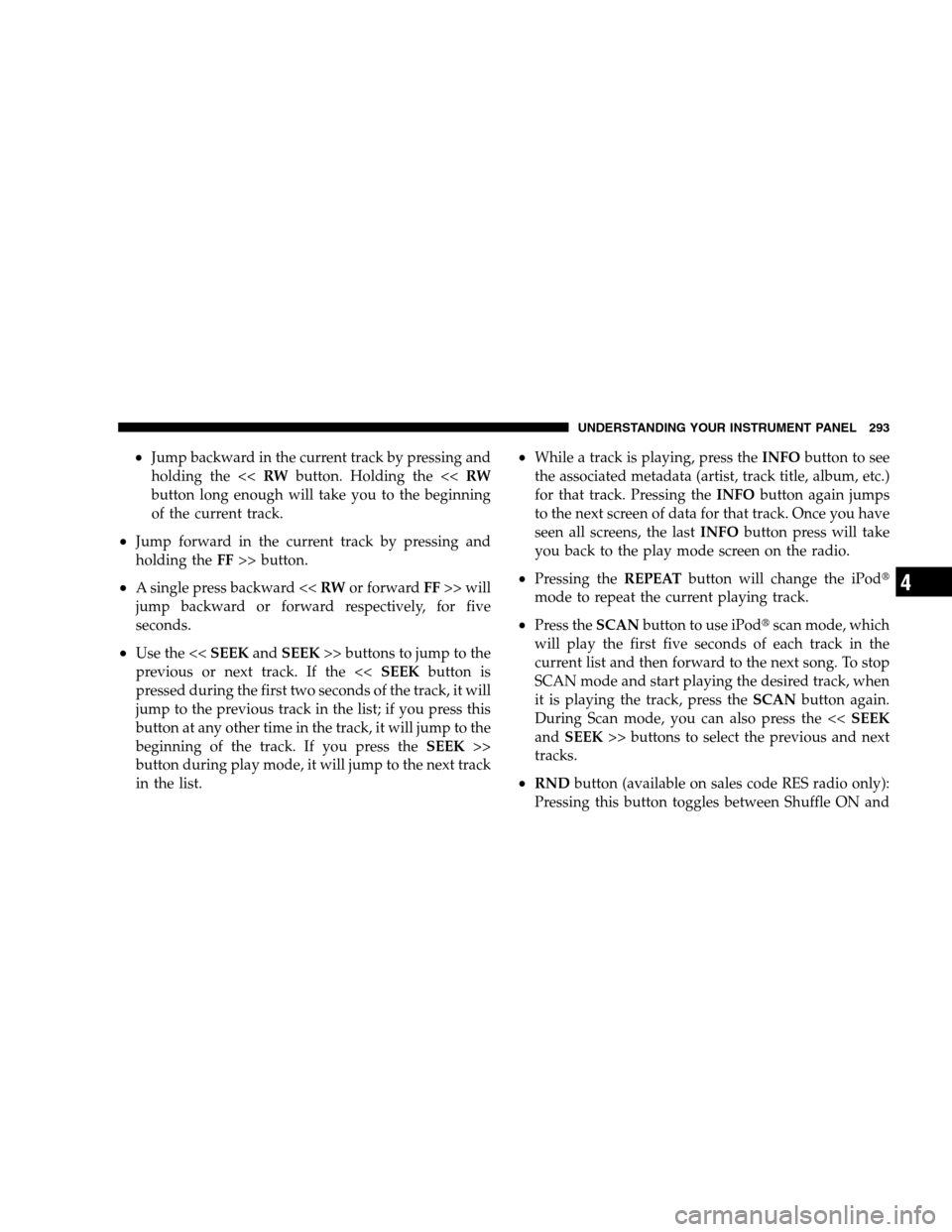
Jump backward in the current track by pressing and
holding the << RWbutton. Holding the << RW
button long enough will take you to the beginning
of the current track.
Jump forward in the current track by pressing and
holding the FF>> button.
A single press backward << RWor forward FF>> will
jump backward or forward respectively, for five
seconds.
Use the << SEEKandSEEK >> buttons to jump to the
previous or next track. If the << SEEKbutton is
pressed during the first two seconds of the track, it will
jump to the previous track in the list; if you press this
button at any other time in the track, it will jump to the
beginning of the track. If you press the SEEK>>
button during play mode, it will jump to the next track
in the list.
While a track is playing, press the INFObutton to see
the associated metadata (artist, track title, album, etc.)
for that track. Pressing the INFObutton again jumps
to the next screen of data for that track. Once you have
seen all screens, the last INFObutton press will take
you back to the play mode screen on the radio.
Pressing the REPEATbutton will change the iPodt
mode to repeat the current playing track.
Press the SCANbutton to use iPodt scan mode, which
will play the first five seconds of each track in the
current list and then forward to the next song. To stop
SCAN mode and start playing the desired track, when
it is playing the track, press the SCANbutton again.
During Scan mode, you can also press the << SEEK
and SEEK >> buttons to select the previous and next
tracks.
RND button (available on sales code RES radio only):
Pressing this button toggles between Shuffle ON and
UNDERSTANDING YOUR INSTRUMENT PANEL 293 4
Page 337 of 535
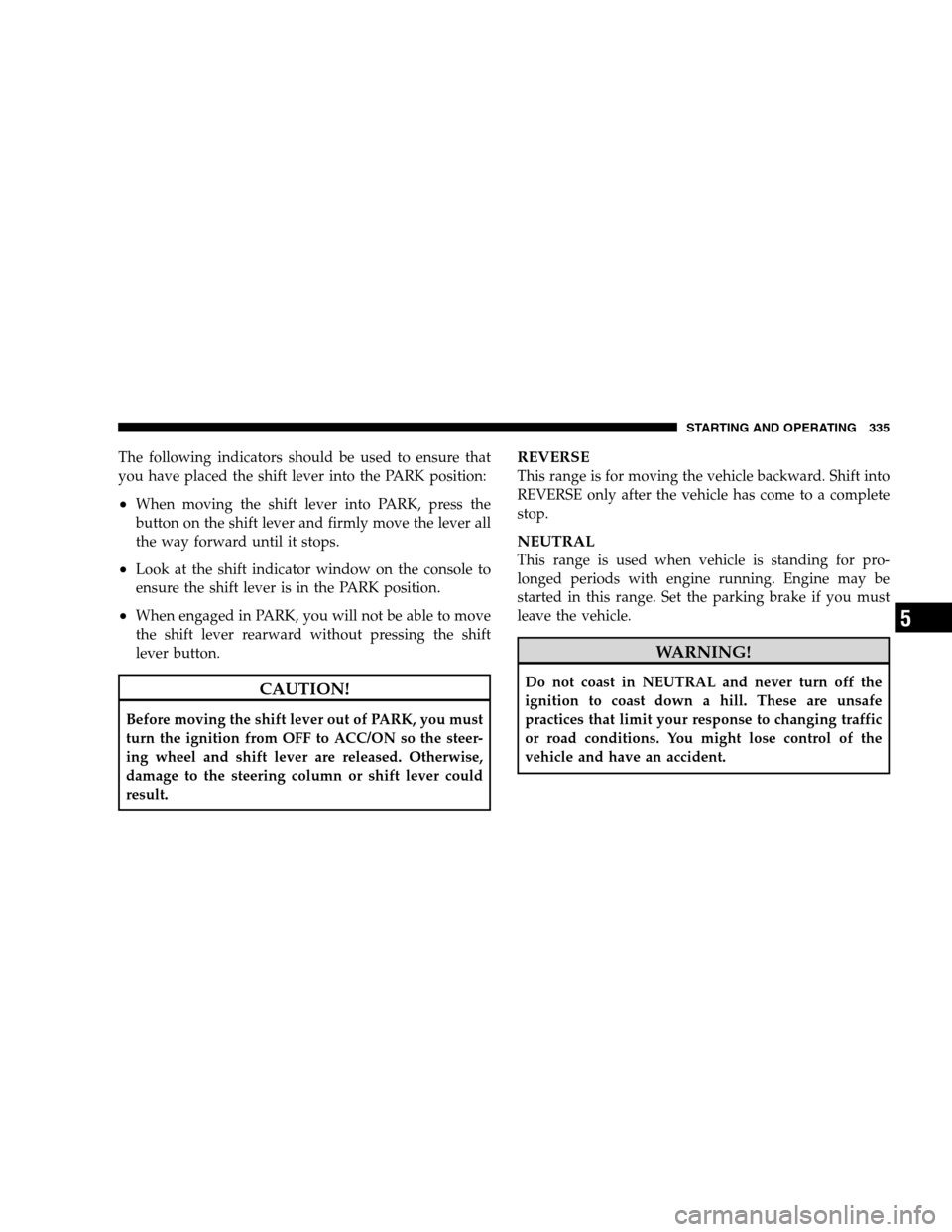
The following indicators should be used to ensure that
you have placed the shift lever into the PARK position:
When moving the shift lever into PARK, press the
button on the shift lever and firmly move the lever all
the way forward until it stops.
Look at the shift indicator window on the console to
ensure the shift lever is in the PARK position.
When engaged in PARK, you will not be able to move
the shift lever rearward without pressing the shift
lever button.CAUTION!
Before moving the shift lever out of PARK, you must
turn the ignition from OFF to ACC/ON so the steer-
ing wheel and shift lever are released. Otherwise,
damage to the steering column or shift lever could
result.
REVERSE
This range is for moving the vehicle backward. Shift into
REVERSE only after the vehicle has come to a complete
stop.
NEUTRAL
This range is used when vehicle is standing for pro-
longed periods with engine running. Engine may be
started in this range. Set the parking brake if you must
leave the vehicle. WARNING!
Do not coast in NEUTRAL and never turn off the
ignition to coast down a hill. These are unsafe
practices that limit your response to changing traffic
or road conditions. You might lose control of the
vehicle and have an accident.
STARTING AND OPERATING 335 5
Page 533 of 535

INTRODUCTION INTRODUCTION HOW TO USE THIS MANUAL WARNINGS AND CAUTIONS VEHICLE IDENTIFICATION NUMBER VEHICLE MODIFICATIONS/ALTERATIONS THINGS TO KNOW BEFORE STARTING YOUR VEHICLE A WORD ABOUT YOUR KEYS
Wireless Ignition
Node (WIN)SENTRY KEY Replacement KeysVEHICLE SECURITY ALARM - IF EQUIPPED Rearming Of The SystemILLUMINATED ENTRY SYSTEM - IF EQUIPPED REMOTE KEYLESS ENTRY (RKE) - IF EQUIPPED Using the RKE TransmitterREMOTE
STARTING SYSTEM - IF EQUIPPED How to Use Remote StartDOOR LOCKS Manual Door LocksPower Door Locks - If EquippedWINDOWS Power Vent Windows - If EquippedPower WindowsSLIDING SIDE DOOR Power Sliding Side Door - If EquippedSliding Side Door
Child Protection LockLIFTGATE Power Liftgate - If EquippedSTORAGE BIN SAFETY WARNING Safety WarningOCCUPANT RESTRAINTS Lap/Shoulder BeltsAutomatic Locking Retractors (ALR) Mode - If EquippedSeat Belt PretensionersEnhanced Seat Belt Use Reminder
System (BeltAlert)Seat Belts and Pregnant WomenSeat Belt ExtenderSupplemental Restraint System (SRS) - AirbagsAirbag System ComponentsFront Seat Airbag FeaturesAirbag Deployment Sensors and ControlsEvent Data Recorder (EDR)Integrated Child Booster Seat
- If EquippedIntegrated Child Seat - If EquippedChild RestraintsREAR SEAT DELETE FEATURE (COMMERCIAL VEHICLES ONLY) - IF EQUIPPED Restraining Infants and Small Children with Seat Delete Feature (Commercial Vehicles Only)ENGINE BREAK-IN
RECOMMENDATIONS SAFETY TIPS Transporting PassengersExhaust GasSafety Checks You Should Make Inside the VehiclePeriodic Safety Checks You Should Make Outside the VehicleUNDERSTANDING THE FEATURES OF YOUR VEHICLE MIRRORS Inside
Day/Night Mirror - If EquippedAutomatic Dimming Mirror - If EquippedOutside MirrorsDrivers Outside Automatic Dimming Mirror - If EquippedOutside Mirror Folding FeaturePower Mirrors - If EquippedHeated Mirrors - If EquippedTilt Mirrors in Reverse (Available with Memory
Seat Only) - If EquippedIlluminated Vanity Mirrors - If EquippedBLIND SPOT MONITORING - IF EQUIPPED Rear Cross PathModes Of Operationuconnect phone - IF EQUIPPED OperationPhone Call Featuresuconnect phone FeaturesAdvanced Phone ConnectivityThings
You Should Know About Your uconnect phoneGeneral InformationVOICE RECOGNITION (VR) SYSTEM - IF EQUIPPED Voice Recognition (VR) System OperationCommandsVoice TrainingSEATS Manual Front And Second Row Seat AdjusterEight-Way Driver And
Passenger Power Seat - If EquippedAdjustable Head RestraintsHeated Seats - If EquippedManual Reclining Seats - If EquippedManual Lumbar Adjust Lever - If EquippedStow n Go Seating - If EquippedEasy Access SeatingSwivel n Go Premium Seating - If Equipped
Second Row Bench Seat - If EquippedThird Row Power Seat - If EquippedDRIVER MEMORY SEAT - IF EQUIPPED Setting Memory Positions and Linking RKE Transmitter to MemoryEasy Entry/Exit Seat (Available with Memory Seat ONLY)TO OPEN AND CLOSE THE
HOOD LIGHTS Interior LightingParking LightsHeadlightsAutomatic Headlights - If EquippedHeadlights On With Wipers - If EquippedHeadlight Delay - If EquippedDaytime Running Lights (Canada/Fleet Vehicles Only)Front Fog Lights - If EquippedBattery Protection
Multifunction LeverTurn SignalsLane Change AssistHigh Beam/Low Beam Select SwitchFlash-To-PassWINDSHIELD WIPER AND WASHERS TILT STEERING COLUMN - IF EQUIPPED ADJUSTABLE PEDALS - IF EQUIPPED ELECTRONIC SPEED CONTROL - IF
EQUIPPED To ActivateTo Set At A Desired SpeedDeactivating Electronic Speed ControlResuming SpeedVarying The Speed SettingAccelerating To PassREAR PARK ASSIST - IF EQUIPPED Rear Park Assist SensorsREAR BACKUP CAMERA SYSTEM - IF EQUIPPED
Turning the Rear Camera On or Off - With Navigation RadioTurning the Rear Camera On or Off - Without Navigation RadioOVERHEAD CONSOLES Front Overhead ConsoleGARAGE DOOR OPENER - IF EQUIPPED Programming HomelinkGate Operator/Canadian
ProgrammingSecurityTroubleshooting TipsGeneral InformationPOWER SUNROOF - IF EQUIPPED Power Sunroof OperationELECTRICAL POWER OUTLETS - IF EQUIPPED POWER INVERTER - IF EQUIPPED CUPHOLDERS Instrument Panel CupholdersInteriorBottle
HoldersSmokers Package Kit - If EquippedSTORAGE Glove CompartmentsDoor Trim Panel StorageDriver Seatback Storage - If EquippedUmbrella HolderSecond Row Seat Storage Bins - If EquippedCoat HooksCargo Area StorageCONSOLE FEATURES Basic Console
Premium Console - If EquippedREAR WINDOW FEATURES Rear Window DefrosterLOAD-LEVELING SYSTEM ROOF LUGGAGE RACK - IF EQUIPPED SUN SCREENS - IF EQUIPPED UNDERSTANDING YOUR INSTRUMENT PANEL INSTRUMENT PANEL FEATURES
INSTRUMENT CLUSTER - BASE INSTRUMENT CLUSTER - PREMIUM INSTRUMENT CLUSTER DESCRIPTIONS COMPASS MINI-TRIP COMPUTER (CMTC) - IF EQUIPPED CMTC Reset ButtonsCompass/Temperature DisplayELECTRONIC VEHICLE INFORMATION
CENTER (EVIC) - IF EQUIPPED Electronic Vehicle Information Center (EVIC) DisplaysTrip FunctionsCompass DisplayPersonal Settings (Customer-Programmable Features)AM/FM/CD/DVD RADIO (RER/REN) - IF EQUIPPED Operating Instructions - Voice Recognition
System (VR) - If EquippedOperating Instructions - uconnect phone - If EquippedClock Setting ProcedureSALES CODE RES - AM/FM STEREO RADIO WITH CD PLAYER (MP3 AUX JACK) Operating Instructions - Radio ModeOperation Instructions - CD MODE For CD
And MP3 Audio PlayNotes on Playing MP3 FilesOperation Instructions - Auxiliary ModeSALES CODE RES/RSC - AM/FM STEREO RADIO WITH CD PLAYER (MP3 AUX JACK) AND SIRIUS RADIO Operating Instructions - Radio ModeOperation Instructions - CD MODE
for CD and MP3 Audio PlayNotes On Playing MP3 FilesLIST Button (CD Mode for MP3 Play)INFO Button (CD Mode for MP3 Play)UNIVERSAL CONSUMER INTERFACE (UCI) - IF EQUIPPED Connecting The iPodUsing This FeatureControlling The iPod Using Radio Buttons
Play ModeList Or Browse Modeuconnect studios (SATELLITE RADIO) - IF EQUIPPED (REN/REQ/RER/RES/REU RADIOS ONLY) System ActivationElectronic Serial Number/Sirius Identification Number (ESN/SID)Selecting uconnect studios (Satellite) ModeSatellite Antenna
Reception QualityOperating Instructions - uconnect studios (Satellite) ModeOperating Instructions - uconnect phone (If Equipped)Operating Instructions - Video Entertainment System (VES) (If Equipped)uconnect studios (SIRIUS BACKSEAT TV) - IF EQUIPPED VIDEO
ENTERTAINMENT SYSTEM (VES) - IF EQUIPPED REMOTE SOUND SYSTEM CONTROLS - IF EQUIPPED Radio OperationCD PlayerCD/DVD MAINTENANCE RADIO OPERATION AND CELLULAR PHONES CLIMATE CONTROLS Manual Heating and Air Conditioning
SystemRear Manual Climate Control - If EquippedAutomatic Temperature Control (ATC) - If EquippedSummer OperationWinter OperationVacation/StorageWindow FoggingOutside Air IntakeOperating Tips A/C Air Filter- If EquippedSTARTING AND OPERATING STARTING
PROCEDURES Automatic TransaxleNormal StartingExtreme Cold Weather (Below -20 degrees F or -29 degrees C)If The Engine Fails To StartAfter StartingENGINE BLOCK HEATER - IF EQUIPPED AUTOMATIC TRANSAXLE Brake/Transaxle Interlock SystemFour-Speed
or Six-Speed Automatic TransaxleGear RangesDRIVING ON SLIPPERY SURFACES AccelerationTractionDRIVING THROUGH WATER Flowing/Rising WaterShallow Standing WaterPOWER STEERING Power Steering Fluid CheckPARKING BRAKE ANTI-LOCK BRAKE
SYSTEM (ABS) Anti-Lock Brake Warning LightELECTRONIC BRAKE CONTROL SYSTEM Traction Control System (TCS)Brake Assist System (BAS)Electronic Stability Program (ESP)ESP/BAS Warning LightTIRE SAFETY INFORMATION Tire Markings TireIdentification
Number (TIN)Tire Loading and Tire PressureTIRES - GENERAL INFORMATION Tire PressureTIRE CHAINS SNOW TIRES TIRE ROTATION TIRE PRESSURE MONITOR SYSTEM (TPMS) Base SystemPremium System - If EquippedFUEL REQUIREMENTS 3.3L/3.8L
Gasoline Engine4.0L Gasoline EngineReformulated GasolineGasoline/Oxygenate BlendsE-85 Usage In Non-Flex Fuel VehiclesMMT In GasolineMaterials Added to FuelFuel System CautionsCarbon Monoxide WarningsFLEXIBLE FUEL (3.3L ENGINES ONLY) - IF
EQUIPPED E-85 General InformationETHANOL FUEL (E-85)Fuel RequirementsSelection Of Engine Oil For Flexible Fuel Vehicles E-85 and Gasoline VehiclesStartingCruising RangeReplacement PartsMaintenanceADDING FUEL Fuel Filler Cap (Gas Cap)Loose Fuel Filler
Cap MessageVEHICLE LOADING Vehicle Certification LabelTRAILER TOWING Common Towing DefinitionsTowing TipsRECREATIONAL TOWING (BEHIND MOTORHOME, ETC.) WHAT TO DO IN EMERGENCIES HAZARD WARNING FLASHER IF YOUR ENGINE
OVERHEATS JACKING AND TIRE CHANGING Jack LocationJUMP-STARTING PROCEDURE FREEING A STUCK VEHICLE TOWING A DISABLED VEHICLE Towing With The Ignition KeyMAINTAINING YOUR VEHICLE ENGINE COMPARTMENT - 3.3/3.8L ENGINE
COMPARTMENT - 4.0L ONBOARD DIAGNOSTIC SYSTEM - OBD II Loose Fuel Filler Cap Message - gASCAPEMISSIONS INSPECTION AND MAINTENANCE PROGRAMS REPLACEMENT PARTS DEALER SERVICE MAINTENANCE PROCEDURES Engine OilEngine
Oil FilterEngine Air Cleaner FilterExhaust SystemMaintenance-Free BatteryAir Conditioner MaintenanceBody LubricationWindshield Wiper BladesCooling SystemBrakesAutomatic TransaxleAppearance Care and Protection from CorrosionCleaning the Instrument Panel
CupholdersFUSES Totally Integrated Power Module (TIPM)VEHICLE STORAGE REPLACEMENT LIGHT BULBS BULB REPLACEMENT HeadlampsFront Park/Turn Signal LampsFog LampsRear Tail, Stop, Turn Signal, Side Marker and Backup LampsCenter High-Mounted
Stop Lamp (CHMSL)License LampFLUIDS AND CAPACITIES FLUIDS, LUBRICANTS AND GENUINE PARTS EngineChassisMAINTENANCE SCHEDULES EMISSIONS CONTROL SYSTEM MAINTENANCE MAINTENANCE SCHEDULE Required Maintenance Intervals
IF YOU NEED CONSUMER ASSISTANCE SUGGESTIONS FOR OBTAINING SERVICE FOR YOUR VEHICLE Prepare For The AppointmentPrepare A ListBe Reasonable With RequestsIF YOU NEED ASSISTANCE Chrysler LLC Customer CenterChrysler Canada Inc.
Customer CenterIn Mexico contactCustomer Assistance For The Hearing Or Speech Impaired (TDD/TTY)Service ContractWARRANTY INFORMATION (U.S. Vehicles Only) MOPAR PARTS REPORTING SAFETY DEFECTS In the 50 United States and Washington, D.C
In CanadaPUBLICATION ORDER FORMS DEPARTMENT OF TRANSPORTATION UNIFORM TIRE QUALITY GRADES TreadwearTraction GradesTemperature GradesINDEX